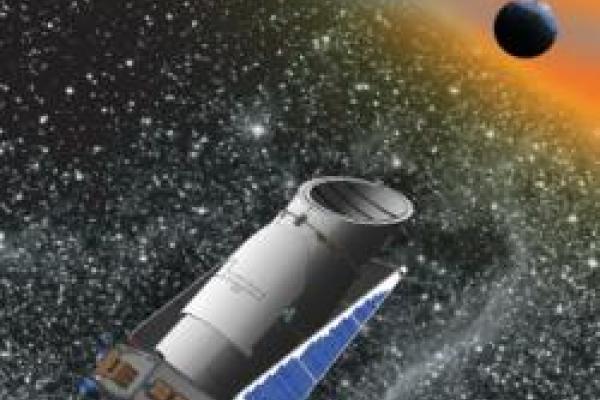KEPLER: A Jewel for Exoplanet Research, but also a Tool for Stellar Astronomy

Unlike his colleagues involved with the Kepler space telescope who are interested in studying exoplanets, Ohio State faculty member Professor Marc Pinsonneault is more anxious to study the stars these planets orbit.
Pinsonneault is currently involved in research that will determine the age and chemical composition of stars that Kepler has observed. Using different methods, Pinsonneault and the graduate students he works with hope to measure the age and chemical composition of these stars to within an impressive accuracy of ten to thirty percent. More accurate telescopes tend to allow for scientific measurements with high precision, which is why Kepler is so important for making these very useful calculations.
Kepler is designed for discovering exoplanets (planets outside of our Solar System). Kepler
detects these planets through the transit method, which measures a dip in the amount of starlight
seen from the telescope; the dip indicates a planet has passed in between the star and the
telescope. This method requires that the telescope closely monitor stars that could potentially be
hosts to orbiting planets.
Since it began observing in 2009, Kepler has nearly tripled the total number of potential
exoplanets from 600 to more than 1,700. In order to do this, the telescope has collected multiple
images of more than 150,000 stars in our galaxy. With these high numbers and the precision
required to identify planets, Kepler is not only an asset to scientists who examine exoplanets, but
it is invaluable for astronomers interested in studying stars.
Like the majority of space telescopes, Kepler is more sensitive than ground-based telescopes,
which makes it highly useful for gathering detailed images of the stars it observes. “Kepler’s
high resolution images of stars have given us a wonderful new opening for studying certain
important properties of stars such as rotation rates and interior structure, which will help us
to deduce the stars’ ages at unparalleled accuracy,” said Pinsonneault. “Never before have
astronomers had such high precision data of so many stars,” he continued.
Knowing where the younger and older stars are located throughout our galaxy is a useful tool
that can be applied to understanding the Milky Way and how it has changed since it first formed,
explained Pinsonneault. Pinsonneault is currently working with graduate student, Courtney
Epstein, to find the ages of stars by looking at how fast they rotate on their axes.
“Stars are born with a wide range of rotation rates, but, as they get older, that range shrinks and
stars spin more slowly. This means that rotation can act as a clock to measure the age of a star,”
said Epstein. “Even with observational uncertainties, we believe that stellar rotation rates of stars
can determine ages to a precision as good as 25%,” she continued.
In addition to getting stars’ ages using rotation rates, Pinsonneault is working with
another graduate student, Jennifer van Saders, to measure stars’ chemical make-up using
asteroseismology.
Asteroseismology studies changes on a star’s surface by wave interaction; similar to
when a tuning fork vibrates at a particular frequency, so too do stars vibrate at frequencies
producing acoustic waves. By analyzing the specific frequencies at which a star vibrates,
asteroseismologists can gather information about the stellar interior and indirectly measure a
star’s chemical abundance.
Although Pinsonneault and van Sanders’s research is in its preliminary stages, they expect
this method will predict the different chemical abundance in stars to within ten percent
accuracy. “With asteroseismology, we can get an absolute measure of a star’s chemical
composition with an impressive level of precision that has been very difficult to achieve before
Kepler’s data,” explained van Saders.
Not only can asteroseismology be used to find the chemical abundance in stars, it can provide
scientists with a basic idea of the star’s internal structure. This is important because it helps
improve astrophysicist’s understanding of the physics governing how heat is transported through
a star – a highly complicated process that is still a subject of ongoing research.
“Kepler has enabled us to raise the bar for accurate measurements of certain stellar properties.
With its precise imaging and large samples we finally have a tool that will help us build our way
towards greater knowledge of stars and galaxies as a whole,” remarked Pinsonneault.
Written by Jessica Orwig
